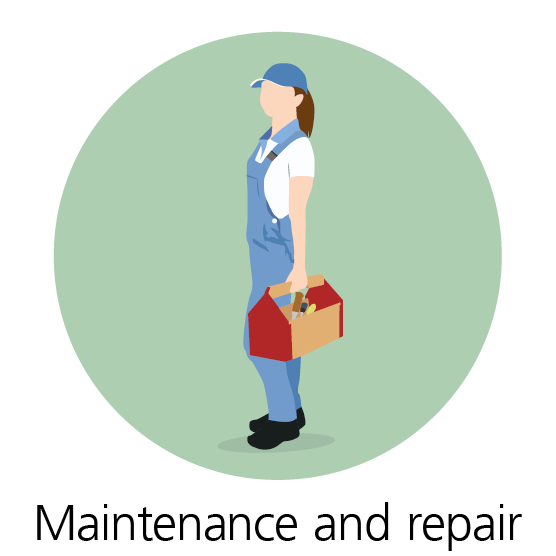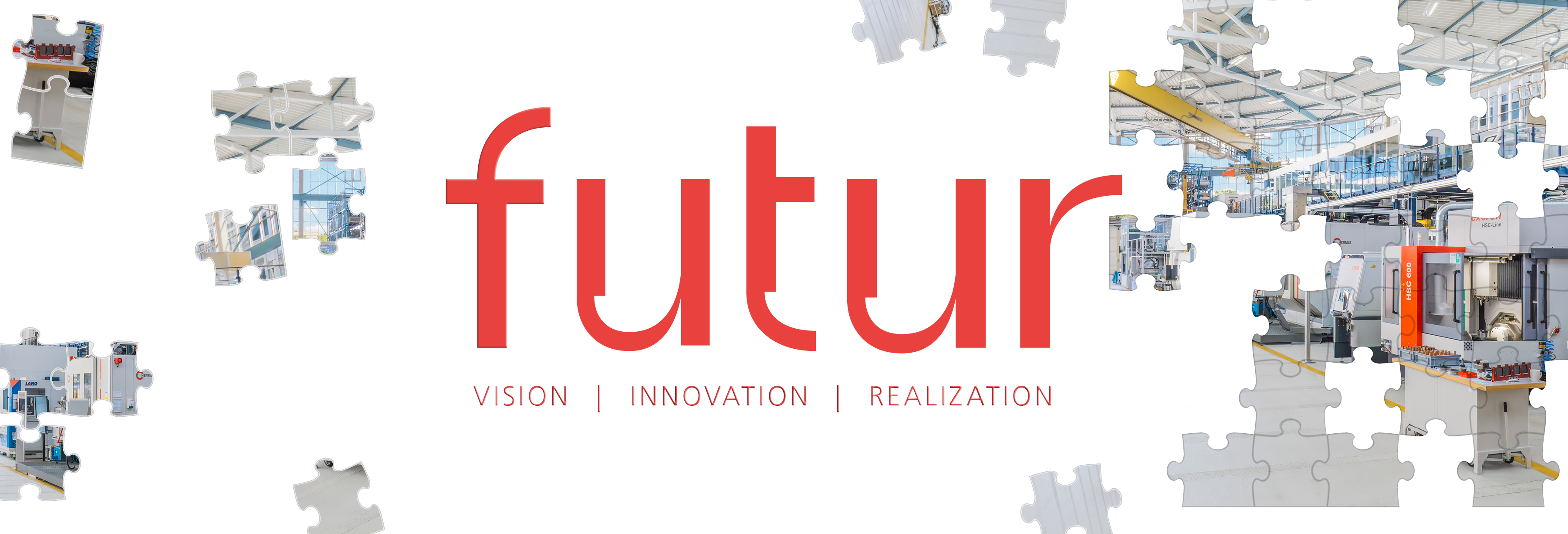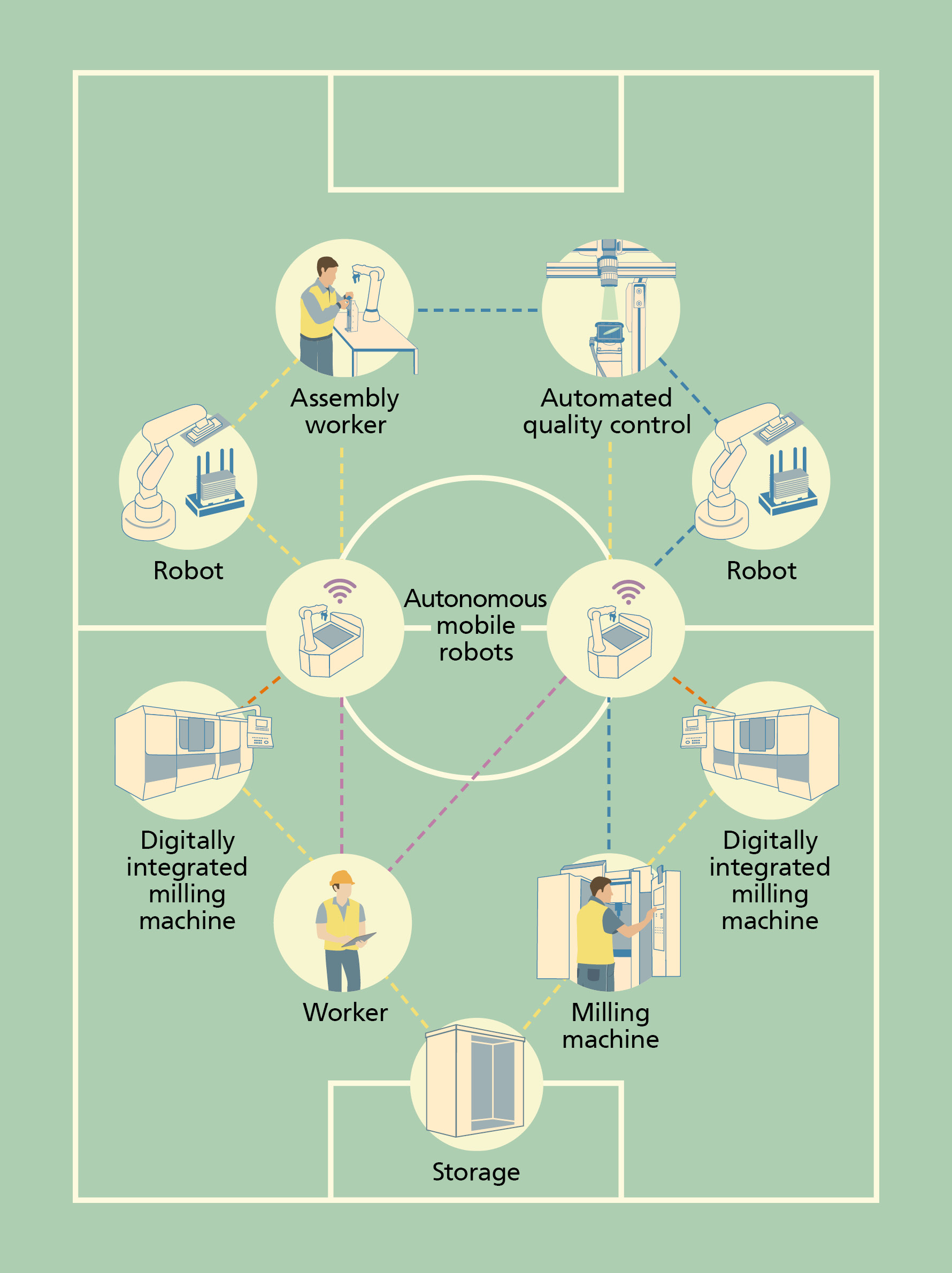Great Machines Think Alike
It is the 83rd minute, the scoreboard is showing 1:1 – the decisive final phase of the game. Flexibility and the ability to react quickly are crucial in order to succeed. And the home team is on the attack once more. This may also involve taking a few risky moves. After a few passes, the ball reaches the striker in the front, now it is on him to put it past the opposing goalkeeper – and just like that, the striker’s shot has got the ball spinning in the net. While the team is celebrating on the pitch, the coach on the sidelines and the team executives in the stands are cheering them on.
Much like on the soccer pitch, a complex, sometimes fast-changing production environment – with machines and human operators, but also different departments and divisions – requires all players to work closely together. Through effective communication between all actors, productivity remains on a high level and continuous production keeps running, ensuring high-quality end products as a result. Despite their common strategic goal, the stakeholders may have different priorities depending on the situation: Production, for example, strives for maximum efficiency and utilization of the available capacity, while the maintenance team is concerned with keeping the machines in optimal condition through regular maintenance and inspections.
Overall success therefore not only depends on the performance or condition of the individual players, but above all on their seamless cooperation. Just like in soccer, where line-ups, tactical strategy, rehearsed sequences and the ability to react to constantly changing game situations are essential, everyone involved, from product development to logistics, must communicate with each other closely and transparently. Only then can potential disruptions or weak points be identified and resolved at an early stage.
In soccer, the fitness of the individual players and the equipment must also be in order so that the team can perform consistently throughout the season and ultimately finish in a good place in the league. Substitutions and giving breaks to particularly important team members are also a part of professional sport. Applied to the production context, regular maintenance measures on machines and systems are essential. However, this is precisely where a classic conflict of objectives arises between uninterrupted production and necessary maintenance.
This conflict is not only a technical challenge but can also determine the economic success of a company: minimal downtime combined with the risk of major damage and production losses due to inadequate maintenance – a balancing act with significant economic consequences. Delayed maintenance often leads to unplanned downtime, which can drive up costs and threaten delivery deadlines. At the same time, poor maintenance planning can impair production efficiency.
Inspired by the human experience
In the Fraunhofer flagship project EMOTION, empathy is the key to resolving this conflict of objectives. As a fundamental psychological concept that strengthens the cohesion of human communities and promotes collaboration, empathy ideally helps the soccer team secure victory. In complex production systems, it can make cooperation between machines and with humans more efficient, effective and robust.
Researchers at Fraunhofer IPK are developing the concept of an empathetic technical system to achieve precisely that. For example, a mobile robot could understand the goals and control variables of other robots around it and proactively support them by flexibly adapting its own role. Or a machine tool could recognize the urgency of production orders and autonomously adapt its operations to fulfill them efficiently. Such systems enable machines to communicate with and support each other, as well as react dynamically to challenges.
What does empathy actually mean?
EMOTION distinguishes between three central forms of empathy that shape human behavior when interacting with others: Cognitive empathy describes the ability to understand the thoughts and perspectives of others, to put oneself in someone else’s shoes and to recognize what they may think or need. Affective empathy goes one step further and refers to understanding and experiencing the emotional states of others. Finally, compassionate empathy combines the insights gained into a proactive action in order to respond to the understanding and perception of other actors’ needs and offer support.
Differentiating between these types of empathy forms the basis for defining requirements for empathetic technical systems and enabling them to act in a similar way to humans in social interactions – with the aim of recognizing conflicts of objectives in production at an early stage and resolving them efficiently.
The goal of EMOTION is consequently to raise all actors in a production system to the level of compassionate empathy. This would mean, for example, that machines are not only able to cognitively grasp the goals and priorities of other machines or systems. In EMOTION, empathetic systems should also do more than just affectively understanding the »mood« or state of others around it – for example, when a machine is »stressed« due to intensive use and its performance must be reduced to avoid overloads. If the machines of the future start to act empathetically as well, they can acknowledge that another system is about to break down, take over tasks proactively or initiate the maintenance process to prevent a production standstill.



Empathetic cooperation in practice
An example from production shows how the integration of empathetic systems works in practice: Two machine tools in a production line are working in parallel on different production orders. Using its integrated sensors and analysis methods, one of these machines notices increasing tool wear. This impending deterioration requires maintenance work to be carried out soon, but the challenge is to plan this maintenance in such a way that the ongoing production process is not interrupted.
In this scenario, the focus is initially on machine-machine interaction. The »compassionate« machine in perfect condition uses its software to request information about the condition of the neighboring machine that is at risk of failure. Together, they analyze the situation: The functioning machine assesses the urgency of current tasks and orders and works with the other machine to determine which of these can be completed safely and which tasks need to be redistributed to enable maintenance to be carried out efficiently. This is not a simple exchange of data, but a deeper form of communication in which the machines make context-related decisions and support each other in their functions.
But these autonomous decisions made by the machines themselves are only the first step. The human worker, in this case an experienced maintenance specialist, is integrated into the process as soon as the machines have completed their analyses. The machines relay their suggested decisions to the specialist, who can now contribute their own process expertise. They review the measures proposed by the machines, taking into account the overall production and possible risks, and adjust the maintenance planning if necessary. This human-machine interaction allows them to verify the machine’s suggestions and supplement them with human experience and knowledge of the entire production process.
Humans play a central role here, even if machines are working together in an increasingly intelligent and integrated way: Not only does maintenance have to be physically carried out by humans, they also have to decide which of the suggested measures to carry out and when these measures should be implemented in order to disrupt production as little as possible. The humans involved interact continuously with the machines by monitoring their status reports and suggestions, validating their decisions and making any necessary adjustments. Humans thus become the conductors of an orchestrated interplay between the machines that aims to optimize the production process.
This close interaction leads to improved flexibility and efficiency in the production process and thus also to the necessary time margins for maintenance measures. The machines take on the task of predictive planning and autonomously proposing decisions, while humans act as strategic leaders and ensure that the machines’ suggestions are in line with the overarching production targets and practical requirements.
If maintenance measures are required, the rescheduling of orders, which is carried out by a technician based on the machine analyses and their own expertise, is immediately forwarded to the material flow system. This synergetic cooperation between human-machine and machine-machine shows how the integration of empathetic systems in production environments also makes optimum use of human expertise.
The factory of the future
Production systems in which the different players communicate and cooperate with each other ensure smooth operation – even in unforeseen scenarios. These innovative technologies offer companies a decisive advantage and show how the factory of the future can be made more resilient, dynamic and productive. The Fraunhofer flagship project paves the way: towards an industry in which machines are not just tools, but become intelligent partners for humans, ensuring the long-term success of a company.
The Fraunhofer flagship project EMOTION
Close cooperation with partners is also essential in research and development – in industrial collaborations as well as research alliances. Large projects can only be successful, if the needs of all involved partners are considered.
This is precisely what the Fraunhofer flagship project EMOTION demonstrates: Since 2023, seven Fraunhofer institutes have been researching a joint vision of the future in which machines look out for and support each other in critical situations. So-called empathetic production systems are intended to enable more efficient and resilient cooperation between the various players in production – this applies to the cooperation between increasingly intelligent machines themselves, but above all to the integration of humans into complex production systems.
Partners in the project:
- Fraunhofer Austria (fraunhofer.at)
- Fraunhofer Institute for Factory Operation and Automation IFF (iff.fraunhofer.de)
- Fraunhofer Institute for Industrial Engineering IAO (iao.fraunhofer.de)
- Fraunhofer Institute for Material Flow and Logistics IML (iml.fraunhofer.de)
- Fraunhofer Institute for Nondestructive Testing IZFP (izfp.fraunhofer.de)
- Fraunhofer Institute for Open Communications Systems FOKUS (fokus.fraunhofer.de)
- Fraunhofer Institute for Production Systems and Design Technology (Coordinator) (ipk.fraunhofer.de)
 Fraunhofer Institute for Production Systems and Design Technology
Fraunhofer Institute for Production Systems and Design Technology
